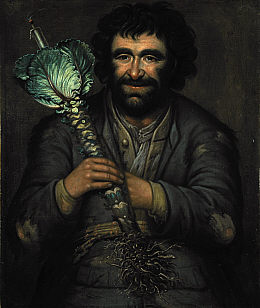On the Sunday before Halloween, this week’s picture is an intriguing eighteenth-century portrait by the Scottish artist Richard Waitt. It was bought last year by the Scottish National Portrait Gallery at the sale, by Christie’s, of the dealer Christopher Gibbs’ idiosyncratic personal collection. In the auction catalogue it was simply listed as A Gardener Holding a Cabbage with a Candle, which begs a few questions. If this grinning, unkempt figure is supposed to be a gardener, why does he have such delicate hands and such immaculately manicured fingernails? Why is he brandishing what seems to be an extremely long cabbage that has been pulled up by the root? And why has a burning candle been inserted into the sprouting end of the aforementioned vegetable?
A complete explanation of these mysteries may prove elusive, but the curator and art historian Hugh Cheape has done some suggestive research into the possible significance of Waitt’s painting. Cheape believes one key to interpreting the work is to be found in Robert Burns’s “Halloween”, a poem describing traditional Scottish practices on the last day of October, when “merry friendly country-folks / Together did convene, / To burn their nits an’ pou their stocks, / An’ haud their Halloween.” Burns provided a useful gloss on the line about “nits” and “stocks” in the 1786 Kilmarnock edition of his Collected Poems, explaining that they refer to divination rituals believed to reveal people’s matrimonial destinies. Burning “nits”, or nuts, on an open fire was a game of prognostication commonly played at Halloween. “They name the lad and lass to each particular nut, as they lay them in the fire; and accordingly as they burn quietly together, or start from beside one another, the course and issue of the courtship will be.” But the opening ceremony of...

ITP 80: Man Holding a Candle in a Cabbage Stalk, by Richard Waitt
28-10-2001

